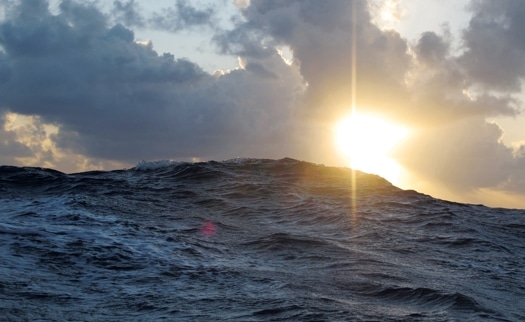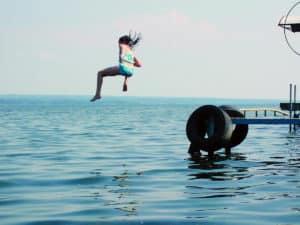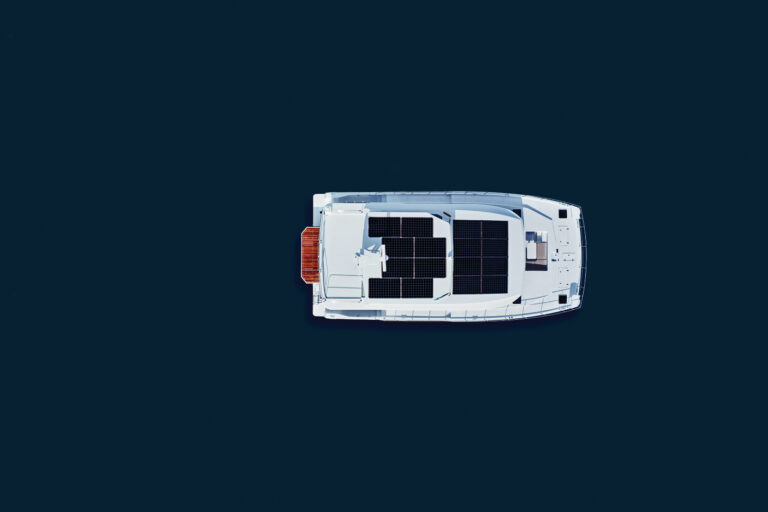
ytgjan27know525.jpg
I once worked for a captain who told me that if I ever thought I knew everything, I’d better hang up my foul-weather gear and take up pottery. He was right. That’s one of the many nuances of boating I love. I maintain there are so many scenarios, combined with a multitude of variables, that it would be mathematically impossible to experience every challenge. And that’s why we should give a wide berth to the self-proclaimed know-it-all.
Knowledge on the water is often gained through mistakes. Over a period of time, confidence will increase and hopefully we will search out new challenges to take us to the next level. A summer cruise to Vancouver may lead to an extended cruise up the Inside Passage. A fall delivery through the inland waters of the East Coast could whet your appetite for a Bahamas adventure the following winter.
Each of these moments away from the dock can bring new experiences. However, there are some skills and tricks that I’ve learned after some bumps and bruises that may decrease your challenge factor. Here are 13 of them.
Know Every Inch Of Your Boat
It seems like a basic prerequisite that you should be familiar with the innards of your boat before leaving the dock. But ask yourself: Do you know the location of every through-hull fitting? If you begin to smell burning electrical wires, can you access your battery-disconnect switches easily? When was the last time you inspected the steering gear?
When I worked as part of the maintenance crew of a charter company, we had a plan-view schematic on each boat that pointed out all the through-hull fittings, fire extinguisher locations, and emergency gear. This sheet was posted above the chart table for easy reference for captain and crew.
Beside these basics, when you’re cruising take the time to figure out various sweet spots for your boat. You can never know too much.

| | |
Keep Those Dead Reckoning Skills Polished
It’s my opinion that if we don’t understand the basic navigational principles, we can’t fully exploit the capability of our electronics. And yes, if you have a solid understanding of navigation you’ll be able to get home in case the electronics fail. Thus dead reckoning is a key skill that any prudent yachtsman must understand. It’s the plotting of an approximate course on a chart relying on speed, time, and distance traveled. A key to dead reckoning is knowing your previous position, and then plotting the course using course steered, speed, and elapsed time.
I highly recommend you plot your position on a paper chart, especially when your electronics are working. How often you do this will depend upon your distance from land and hazards. Once you have your starting point on the chart, you can draw your intended course. Then it’s a matter of plotting the distance (D) along the course using speed (S) and the elapsed time (T). Three formulas we all should know are D=ST, S=D/T, and T=D/S. You may want to get kids or grandkids involved in learning this as well. It will keep them busy and help to develop future mariners who know the basics. Next steps: Make sure you have a set of dividers, parallel rules, the correct paper charts, and some sharp pencils.

| | |
Easy Steps To Determine Distance-Off
Knowing your distance off land or a navigational aid is helpful. Even for peace of mind. During a passage along the coast of Eleuthera, we passed East End Point. Digging out our hand-bearing compass, I took a bearing on the light when it was 45 degrees off our port bow, maintained course, and then took another bearing when the light was 90 degrees off our port beam. The distance run between the two bearings is equal to the distance offshore. The two legs of the triangle that meet to form the 90-degree angle are equal. So if we traveled 4.2 miles from where the light was at 45 degrees to where it was at 90 degrees, then that point of land is 4.2 miles away. (On my old sailboat, I marked the 45- and 90-degree marks on my lifeline with tape.) Next steps: Include a hand-bearing compass in your navigational tools. They aren’t just for racing.
Operating In Heavy Seas
I wouldn’t dare try to explain running in heavy seas within this short article. But the point is you can’t rely on textbook explanations to pilot your boat in heavy weather. Learn your boat’s capabilities and its specific handling characteristics while the conditions are still manageable. The trick is finding your boat’s sweet spot in a specific set of conditions, and this will take a little experimentation. And be aware, boats can break. Flying off the top of a wave at 35 knots may make for a nice picture in an ad, but if you’re not kind to your lady, don’t be surprised to find various forms of protest. You do have to drive your boat.

| | |
Be Able To Read The Clouds
Even with a sophisticated navigational suite, you need to be aware of what is going on around your yacht. Clouds are among the most visible indicators of weather and can often help predict thunderstorms, an approaching front, rain, or a squall.
Start by learning to identify cloud forms and how they may affect weather. This may feel like your kid’s eighth-grade science project, but it’s a necessary first step. Although there are infinite shapes a cloud can take, the common classification system includes 10 types: cumulonimbus, cumulus, stratus, stratocumulus, nimbostratus, altostratus, altocumulus, cirrostratus, cirrocumulus, and cirrus. It’s important to learn the characteristics of each cloud type. Books such as Chapman Piloting offer a good overview and helpful pictures. Next, watch how clouds form in your area, determine whether they are increasing or decreasing in amount, and understand what shape they are taking. As a general rule, lowering or thickening cloud formations indicate wet weather is on the way. Then, begin to combine this information with other items such as barometric pressure and wind velocity.
First Aid And CPR
There’s nothing worse than seeing a loved one wounded or sick-except maybe being unable to do anything about it. First of all, I shake my head at people who have $100,000 worth of flatscreen televisions on board, but are only equipped with a basic first aid kit that can barely mend a scraped knee. Buy the best kit you can afford, then ensure you and your mate take a first aid course. Even if you’re within sight of land, knowing how to dress a wound to stop bleeding, or brace somebody until help arrives, will make a crucial difference. I also strongly believe in equipping a boat with an AED to address cardiac arrest. For about $1,400, you can equip your boat to save somebody’s life. And it only costs about as much as one TV! Make sure you also sign up with your local Power Squadron or firehouse and take a CPR course. Next steps: Check out the first aid kits at www.coastlineadventures.com_ _and log onto www.westmarine.com_ _to order your Charles Industries Heart-Sine AED.

| | |
Action Steps Before The Weather Turns Foul
The basic goal of any yachtsman is to avoid foul weather, but as we all know, it’s bound to find us sooner or later. if you cannot make it into a safe port, you’ll need to take some action. We’ll assume that you already took the time to go through the boat with your crew for a proper safety briefing before you left. also, if you have a properly maintained boat, you’ll fare better. (That’s the subject of many books!) if you find yourself with an approaching squall, or sustained gale-force conditions, you can take steps ahead of time that will improve the safety and comfort of your crew.
Understand Weather Chart Basics
**** I once sent weather forecasters into a tizzy when I published an article on forecasting weather. I wasn’t suggesting that we can all become armchair weather forecasters. I do suggest, however, that it is up to individual captains to understand their weather. Thanks to new electronics, getting an accurate forecast has never been easier. Yet, you still need to understand what you’re looking at on the screen. Charts for surface-weather analysis, surface-weather prognosis, and extended surface prognosis will help you make sense of atmospheric weather conditions just above the water. Wave-height analysis and wave prognosis will keep you abreast of what’s happening on the water. Radar charts and satellite-weather pictures are good for providing up-to-the-minute information about local disturbances.
VHF Radio Tips
Okay, maybe I sound like I’m preaching here, and chances are most of you know how to properly use a VHF, so forgive me. However, on any given summer weekend in my home waters, I hear a kid screaming into the mic or the U.S. Coast Guard coming on multiple times asking somebody to move their chatter to a working channel. Here are a few tips that will help us all.
Make sure you switch to a working channel once you make contact with the party you’re trying to hail, so you can make way for others and your conversation won’t be stepped on.
Try to keep conversations on the relatively short side. I once heard an excruciating call from a captain trying to give somebody directions. If you’re coastal cruising, try the cell phone for long conversations.
Avoid using channel 16 for radio checks. Do not call the Coast Guard for radio checks. It’s not their job.
Use channel 9 for hailing, not 16. This measure was established to limit the congestion on channel 16 and keep it free for emergency situations.
In case of emergency, speak clearly, deliberately, and with the mic away from your mouth.
MOB Drill
Last summer, I participated in the annapolis to newport race. One of the race requirements was executing a man-overboard-drill with a person in the water. Two months before the race, we did our duty. Our captain ensured everyone knew their role. During the drill we discovered a few issues that needed to be corrected. I suggest a MoB drill be performed at the beginning of each season. Do you have a high freeboard powerboat? If so, how will you get back on board? Do you trust your crew to be able to mark the spot on the GPS, deploy a flotation advice, and get you back on board safely? Take your time to answer. A MOB drill will help. Trust me.
Keep The Water Out
There is nothing that sucks your breath from your lungs quicker than lifting the sole to find rivers of water where you usually see a barren bilge. Before you leave the dock, ensure your bilge pumps are properly sized. Unfortunately, quite a few builders install inadequately sized pumps. Install an electric bilge pump that can keep up with the inflow of water if the largest inlet fails to be safe. For many yachts, this would be the raw-water intake. I’m also a fan of yachts with raw-water sea chests and common drains that tie incoming and outgoing water into a common source, reducing the number of penetrations in the hull. Also, be sure to have properly sized built-in manual pumps on board that can continue to operate if you lose power. Install engine intakes with a bilge suction bypass, which are easy to operate. The principle is simple: If a large amount of water is coming in, a valve is turned (some systems require a plug to be removed), and the running engines suck water from the bilge, not the sea.

| | |
Setting The Anchor
Know how to drop and secure the hook for typical cruising endeavors. Ensure your boat is properly equipped with the correct anchor. Also make sure you’re set properly before you turn off the engines. I was once off Sicily and we jumped in to cool off, then noticed the boat was drifting. We had to swim like hell to get out of the captain’s way so he could start the engines. Next steps: Click here_ _for a complete anchoring guide.
Current and Tide Basics
On some boats, an adverse current will not prohibit the ability to get underway. However, it may be nice to place a few knots of current behind you.
Make tide and current awareness part of your predeparture checklist. Ensure you know the time, strength, and direction of tidal currents. Most new electronic software has a very easy to use tide function. I also keep a tide table at my house to reference before I leave for the boat. Next steps: For those who have dived into the world of smartphone apps, try the Tides or Marine Tides apps.
If you have tips or secrets you’ve learned while on the water, I would love to hear them. please e-mail me at [email protected], and include your name and boat type. We’ll be sure to incorporate them in a follow-up article. Happy cruising.









